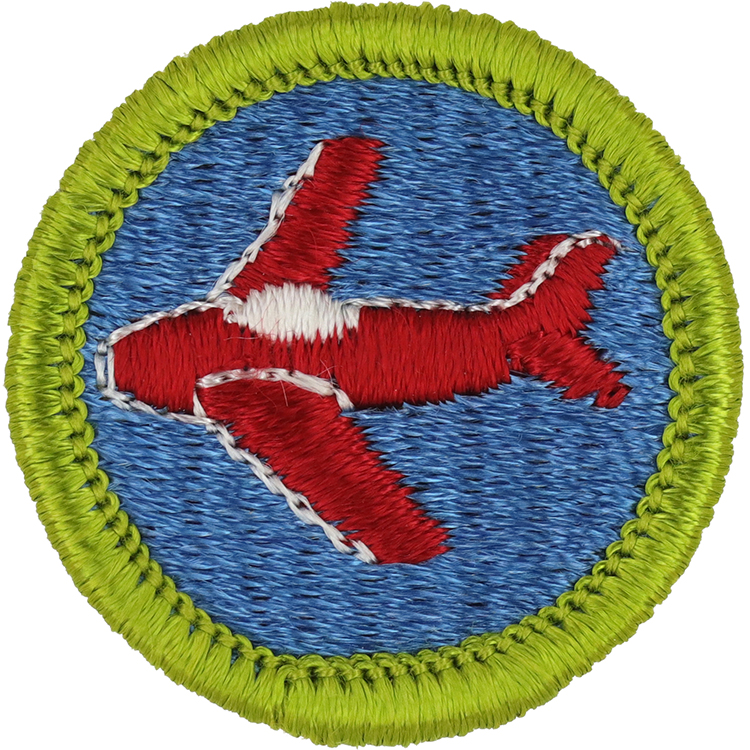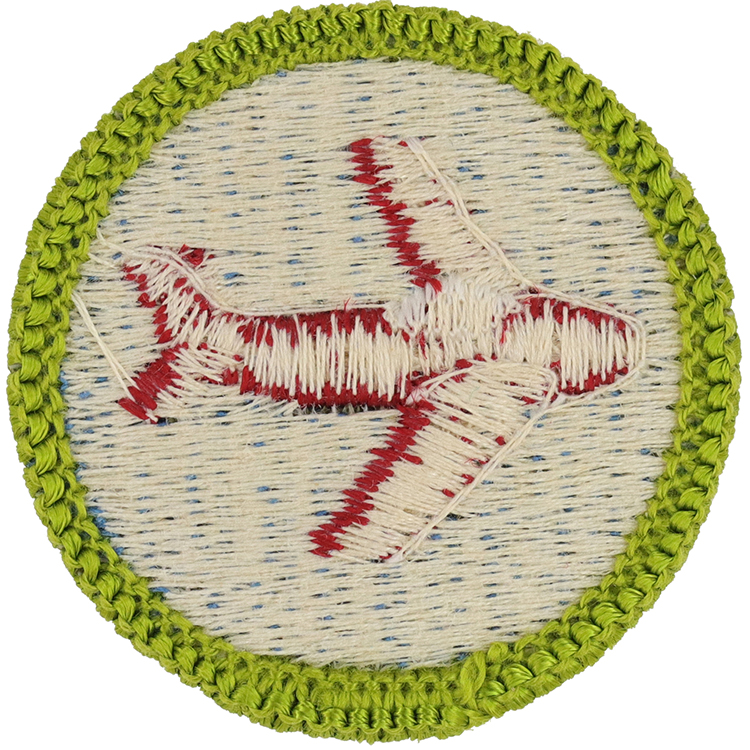
Fig. 1: Aviati-G2-Front
- Embroidery: Cotton thread
- Border: Merrowed

Fig. 2: Aviati-G2-Reverse
- Back: Starched cloth
Item Name: Aviation 1962 - 1972
Item ID: Aviati-G2
Collector Rating: 1
Requirements June 1954 until September 1967
1. (a) Describe briefly how aviation has “shrunk” the world. (b) List at least ten uses of aircraft in modern life.
2. (a) Identify real examples, models or illustrations of each of the following general kinds of aircraft: landplane, seaplane, flying boat, amphibian, helicopter, blimp, dirigible, balloon. (b) Identify in the air, or from silhouettes seen for only five seconds each, at least six types of aircraft by name and model.
3. (a) With a model plane point out the forces which act on an airplane in flight. (b) Build a model airfoil wing section and demonstrate with it the principles of lift; OR build demonstration airfoils which compare the drag effects of streamlined and nonstreamlined surfaces.
4. Show how the working control surfaces (ailerons, rudder and elevators) of an airplane are operated for take-off, climbing, banking and turning, descending and landing.
5. Point out the following instruments on an instrument panel and explain the purpose of each: altimeter, air-speed indicator, compass, bank-and-turn indicator, tachometer, and oil pressure and temperature gauges.
6. Explain by use of models or illustrations the operation of piston, jet and rocket types of engines.
7. Point out six rules of safety to observe around airplanes and flying fields.
8. Build and fly a rise-off-ground model airplane (you may use a kit but must carve the propeller yourself); OR build two solid scale model planes (kits may be used).
9. Do any two of these projects:
a. Take an orientation flight in some type of aircraft.
b. On a map mark a route for a proposed air tour of at least 3,00 miles, starting from the commercial airport nearest your home, and traveling over three or more different airlines. From airline timetables decide on scheduled times of departure and arrival for all stopover and connecting points. Prepare a list of important places of interest and geographical features to see en route.
c. Visit a well-equipped airport and observe how facilities are used for sheltering, servicing, dispatching and signaling aircraft.
d. Make up a pilot’s check-list for a routine preflight inspection of a light airplane.
e. Learn how to read an aeronautical chart.
f. Measure a true course on the chart and correct it for magnetic variation, compass-deviation and wind-drift in order to arrive at a compass heading.
g. Build a gasoline-powered, rise-off-ground model plane that will fly at least 50 seconds. (A kit may be used.)
h. Take part as a contestant or official in a recognized model air meet.
I. Find out what life work opportunities there are for a young man in the field of aviation. Look into the necessary qualifications and working conditions of one job in which you are especially interested, and into the possibilities it offers for reaching your goal in life.
Requirements September 1967 until June 1972
1. Do the following:
(a) Describe briefly how aviation has affected our world.
(b) Define “aircraft” and describe some of the different kinds of aircraft that are in use today.
(c) List at least 10 uses of aircraft in modern life.
2. Do the following:
(a) With a model plane point out the forces which act on an airplane in flight.
(b) Demonstrate one of the other scientific principles basic to flight.
(c) Build a model airfoil wing section and demonstrate with it the principle of lift; OR build demonstration airfoils which compare the drag effects of streamlined and nonstreamlined surfaces.
3. Show how the working control surfaces (elevator, rudder, and ailerons) of an airplane are operated for takeoff, straight climb, level turn, climbing turn, descending turn, straight descent, and landing.
4. Identify the following aircraft instruments and explain the purpose of each: altimeter, airspeed indicator, compass, turn and bank indicator, tachometer, and oil-pressure and temperature gauges.
5. Demonstrate that you know the International Phonetic Alphabet used in aviation.
6. By the use of models or illustrations explain the differences in the operation of piston, turboprop, pure jet, and rocket types of engines.
7. Point out six rules of safety to observe around airplanes and flying fields. Describe safety rules for building and flying model airplanes - rubber power, gas engine (free flight, U-control, or radio control), use of glue, paint, dope, and plastic material.
8. Build and fly a rise-off-ground model airplane (you may use a kit but must carve the propeller yourself); OR build two solid scale model planes (kits may be used).
9. DO ant TWO of these eight projects:
(a) Take an orientation flight in some type of aircraft. Record the date, place, type of aircraft, duration of flight, and your impressions of the flight.
(b) On a map mark a route for a proposed air tour of at least 3,000 miles, starting from the commercial airport nearest your home, and traveling over three or more different airlines. From airline timetables decide on scheduled times of departure and arrival for all stopover and connecting points. Prepare a list of important places of interest and geographical features to see enroute.
(c) Visit a well-equipped airport and observe how facilities are used for hangaring, servicing, dispatching, and controlling or communicating with aircraft.
(d) Make up a pilot’s checklist for a routine preflight inspection of a light airplane.
(e) Learn how to read an aeronautical chart (symbols and the actual plotting of a flight). Measure a true course on an aeronautical chart and correct it for magnetic variation, compass deviation, and wind drift in order to arrive at a compass heading.
(f) Build a gasoline-powered rise-off-ground model plane that will take off and land, or fly a radio-controlled model plane. (A kit may be used.)
(g) Take part as a contestant or official in a model air meet recognized by the Academy of Model Aeronautics.
(h) Find out what career opportunities there are for a young man in the field of aviation. Describe the necessary qualifications and working conditions of one job in which you are especially interested, and the possibilities it offers for reaching your goal in life.



